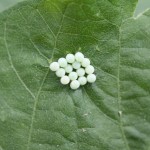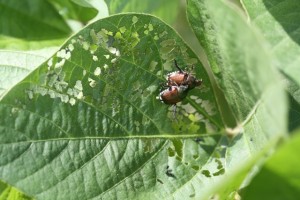There have been several more reports of threecornered alfalfa hopper (TCAH) infestations in seedling soybean where a high percentage of plants have been girdled. Plants less than 10 inches tall are susceptible to girdling. The girdling will not directly cause yield loss unless plants lodge. Lodging often occurs later in the season and especially where stands are thin. Please refer to my previous blog article about TCAH. As a reminder, this pest is usually a problem in reduced tillage fields. Insecticide seed treatments will typically prevent serious damage. Treatment is recommended when 10% of more of plants show signs of girdling. It is important to check for the presence of this pest while plants are small. bugGreen stink bugs are already present in some early maturing fields. The first flowering fields in an area will often act as a magnet for adults. I’ve observed numerous egg masses in fields here in Jackson (pictured right). Treatment is recommended from R1 – R7 when 36 stink bugs are found per 100 sweeps. Synthetic pyrethroids are the standard insecticides of choice. Suggested products and rates are available in UT’s Insect Control Recommendations for Field Crops (PB1768).
Green cloverworms and Japanese beetles are also being found in

most areas, but neither has been reported at treatable levels. These pests feed on leaves. Prior to flowering, treatment is recommended when defoliation exceeds 30-35%, dropping to 20% once flowering begins. It takes a lot of green cloverworms to cause this level of injury, usually 2 or more larvae per sweep. Green cloverworm is the caterpillar that will be most likely be found at this time of year. These can be distinguished from other caterpillar pests by the three pair of prolegs that are present in the middle of the body (pictured below). The larvae will often wriggle violently when touch. My counterpart in Arkansas, Dr. Gus Lorenz, mentioned that they are finding high numbers of yellowstriped armyworms causing defoliation in some fields of seedling soybean. This insect is rarely a pest but we had some issues last year on late planted soybean. All of these critters are economically controlled with synthetic pyrethroid insecticides, but there are several other options that will also control cloverworms or yellowstriped armyworms.
Green cloverworms and Japanese beetles are also being found in most areas, but neither has been reported at treatable levels. These pests feed on leaves. Prior to flowering, treatment is recommended when defoliation exceeds 30-35%, dropping to 20% once flowering begins. It takes a lot of green cloverworms to cause this level of injury, usually 2 or more larvae per sweep. Green cloverworm is the caterpillar that will be most likely be found at this time of year. These can be distinguished from other caterpillar pests by the three pair of prolegs that are present in the middle of the body (pictured below). The larvae will often wriggle violently when touch. My counterpart in Arkansas, Dr. Gus Lorenz, mentioned that they are finding high numbers of yellowstriped armyworms causing defoliation in some fields of seedling soybean. This insect is rarely a pest but we had some issues last year on late planted soybean. All of these critters are economically controlled with synthetic pyrethroid insecticides, but there are several other options that will also control cloverworms or yellowstriped armyworms. Green cloverworm


